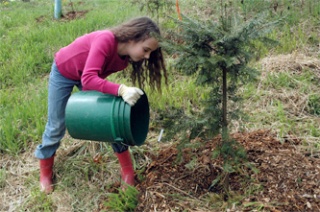MARYSVILLE — At least 75 regional residents arrived in the Meadow Creek neighborhood at 10 a.m. April 18, armed with shovels, buckets, wheelbarrows and mulch to do their part on behalf of the local ecosystem.
In honor of Earth Day, members of the Allen/Quil Ceda Watershed Action Team joined the Meadow Creek Homeowners Association, and other volunteers, in three hours of work on the next stage of a Quil Ceda Creek stream-side restoration project that began in 2007.
The ‘AQWA Team’ includes representatives of the Adopt-A-Stream Foundation, the cities of Marysville and Arlington, the Snohomish Conservation District, Snohomish County Surface Water Management, the Stilly/Snohomish Task Force, the Tulalip Tribes and the Washington State Department of Ecology. At the same time, an estimated majority of the volunteers at Quil Ceda Creek April 18 were children, many of them drawn from area Scout troops.
Historically, Quil Ceda Creek was one of the best Coho streams in the Snohomish River system, but the effects of development in the watershed have resulted in a rapid decline in the numbers of salmon.
The stream-side restoration project began two years ago, on a 12,000-square-foot area next to the Middle Fork of Quil Ceda Creek, where logs and stumps were installed in the stream channel, to provide hiding places for juvenile salmon, and more than 600 native trees and shrubs were planted. On April 18, mulch barriers were laid down around the trees and shrubs, to help them retain water, and to create barriers between them and competing plants, such as weeds.
As these trees and shrubs grow, they provide shade and cooler water temperatures for the creek’s salmon and trout. Adopt-A-Stream Foundation Ecologist Jennifer Adams and Snohomish County Surface Water Management Watershed Steward Cindy Flint explained that these trees and shrubs also create habit for other animals, including birds and insects, the latter of which serve as food for the fish. They added that volunteers are given information about non-native invasive plants, such as Himalayan blackberries and reed canary grass, that need to be pulled out.
Tiffany Howell is studying anthropology at Everett Community College, and the creek restoration counted as field work for her. She nonetheless enjoyed working up a sweat as she helped her fellow volunteers shovel approximately five dump truck loads of mulch into waiting buckets and wheelbarrows.
“I feel the burn in my arms, but it’s a great experience to be involved in,” Howell said. “Everyone should do their part. I wasn’t expecting to see so many young people here. It’s great that they’re getting involved so early.”
Boy Scouts Klahaya District Commissioner David Read was one of many Scouting representatives on hand for the event. He hauled handcarts full of buckets between the mulch pile and the trees, and appreciated that so many Scouts could take part in such an event, in spite of their increasingly busy spring-summer schedules.
“It’s a nice program for younger kids,” said Read, who works as a professional conservation advisor. “Tree-planting is good, but it requires more digging and that can be difficult for some of the younger kids. Shoveling bark and hauling it around is a lot easier for them and it lets them feel more connected to the work.”
Everett Scouts Dakota Brightwell, 8, and Eleanore Johnson, 11, made sure to leave space between the mulch and the tree trunks to avoid causing trunk rot. Brightwell is a member of Wolf Pack 25, and his mother, Sharon, praised the event organizers for giving volunteers of all ages an opportunity to “keep the world looking green.” As for Johnson, a member of Girl Scouts Troop 53243, she had taken part in a tree-planting in another area a few years ago, so by performing the follow-up work on the trees at Quil Ceda Creek, she felt like she was seeing the next step of her own earlier work.
“Everyone should do something,” Johnson said. “Instead of just expecting miracles, they need to step up.”
Click here for more photos.



